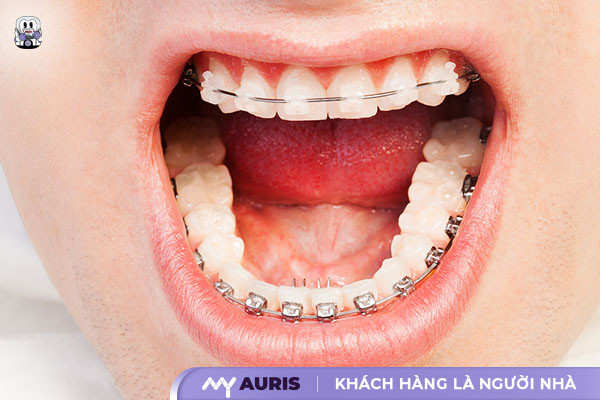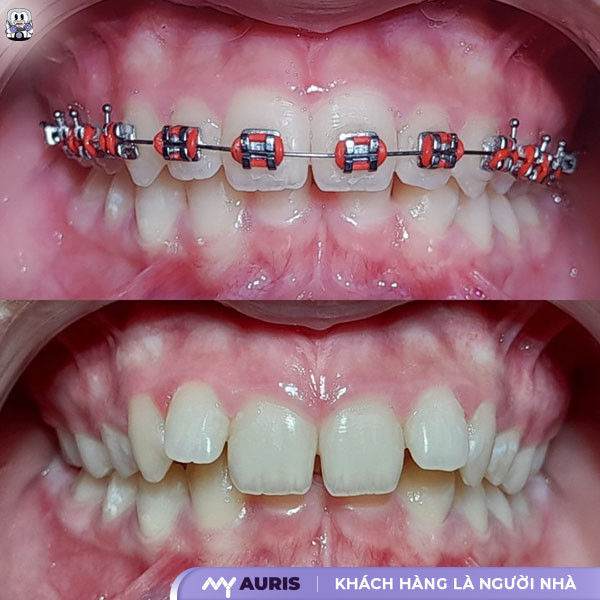Many people visiting My Auris Dental Clinic wonder about the duration of braces treatment. “How many years does it take to complete braces?” is a common question. The answer is not simple. This article will help you better understand the factors affecting orthodontic treatment time.
How many years does it take for braces to achieve perfectly aligned teeth?
Everyone wants the braces treatment process to be quick. Many are concerned that the wearing period will be prolonged, affecting their daily lives. Understanding the average braces treatment time and influencing factors helps patients prepare well.
Typically, braces treatment time ranges from 12 to 36 months. This is only an estimated time frame. Very short treatment times are rare. It is impossible for braces treatment time to remain unchanged throughout the course. Personalization in orthodontics is crucial. Each patient has a unique treatment duration, depending on their dental condition. The age for braces is also an important factor. Children usually have shorter treatment times than adults because their jawbones are still developing.

Children’s Braces Treatment Time by Development Stage
Stage 1: Early orthodontic treatment from 8–10 years old
At this age, children begin to replace primary teeth with permanent ones. This is an ideal time for pediatric orthodontic intervention, with the main goal of correcting early dental misalignments, while arranging teeth into their correct positions, facilitating the proper eruption of permanent teeth.
Because this is a stable developmental stage, early orthodontic intervention will help limit major discrepancies later on, while shortening and simplifying future orthodontic treatment.
Stage 2: Rapid development during adolescence
As children enter puberty, their jawbones develop rapidly, making this a crucial time for dentists to intervene more deeply. Based on the rate of jawbone development, the dentist will adjust the jaw and facial structure, while repositioning teeth evenly in the dental arch, ensuring both aesthetics and chewing function.
If a child has had early orthodontic treatment in Stage 1, the likelihood of tooth extraction in Stage 2 is very low. In reality, the decision to extract teeth must be carefully considered. The dentist will monitor the child’s development before deciding whether or not to extract. Incorrect timing of tooth extraction can complicate subsequent orthodontic treatment.
In some cases, if the child’s teeth and jaws develop well in Stage 1, no further treatment is needed in Stage 2.

How Long Do Braces Take for Adults?
Thanks to modern orthodontic techniques, braces for adults are no longer as complicated as before, while still achieving high effectiveness. By adhering strictly to the braces treatment plan and following all instructions from the dentist, you can significantly shorten the treatment time and quickly reach the stage of braces removal.
Typically, an average adult braces case will last from 6 months to 1.5 years. However, for more complex conditions such as overbite, underbite, or severely crowded teeth, treatment time can range from 2 to 3 years.
Nevertheless, you can still shorten the braces treatment time if you diligently follow your appointment schedule and cooperate closely with your dentist throughout the treatment process. Maintaining regular check-ups not only ensures the results but also helps detect and promptly address any issues that may arise.
Key Factors Affecting Your Orthodontic Treatment Time
The duration of wearing braces is undoubtedly your primary concern. The braces treatment plan is not fixed. It depends on many factors. Understanding these factors will help you prepare better for the orthodontic process:
Age for braces:
Children are in the jawbone development phase. The braces treatment period is usually shorter for children than for adults. Adult jawbones are fully developed. The average braces treatment time may be longer, requiring patience. Age-related changes affect treatment time. Braces treatment time also varies for different types of teeth.
Degree of dental misalignment:
For mild misalignments, orthodontic treatment time is shorter. In cases of complex misalignments, the duration of wearing braces will be longer. The dentist will assess the dental condition. From there, a suitable treatment plan will be provided. The dental treatment process will be individualized. The braces treatment time depends on the dental condition.
Type of braces:
Different types of braces affect the orthodontic treatment time. Traditional metal braces usually have a shorter active treatment time than ceramic braces. Invisalign clear aligners have varying treatment times depending on the case. Comparing the treatment durations of different methods helps you choose the most suitable one. The type of braces impacts the completion time.
Treatment plan:
The treatment plan is determined by the dentist. This plan is based on the dental condition, age, and type of braces. Each patient has a unique treatment plan. The braces process is meticulously planned. The duration of wearing braces is specifically calculated. The orthodontic schedule is clearly established.
Patient compliance:
Oral hygiene care during braces treatment is very important. Adhering to the dentist’s instructions helps ensure a smooth treatment process. Attending appointments on time and maintaining proper oral hygiene shorten the duration of wearing braces. The cooperation between the patient and the dentist determines the treatment’s effectiveness. The importance of cooperation is emphasized.
Comparing Braces Treatment Times Among Popular Methods
The orthodontic process requires patience, and understanding the treatment time for each method will help you prepare better.

Metal Braces
This traditional method uses metal brackets and archwires to move teeth. The average treatment time for metal braces is 18 to 24 months. This time frame is an estimate. The duration of wearing braces depends on the degree of dental misalignment, the age of the patient, and the patient’s adherence to oral hygiene care during treatment. The orthodontic schedule needs to be closely monitored by the dentist.

Ceramic Braces
Similar to metal braces, ceramic braces offer higher aesthetics. Treatment time is usually comparable to metal braces, approximately 18-24 months. The cost of ceramic braces is typically higher than metal braces. The choice depends on aesthetic needs and the long-term cost of braces.

Clear Aligners (Invisalign)
This method uses clear, almost invisible aligners. Very short treatment times can be achieved in some simple cases. However, the average orthodontic treatment time with Invisalign typically ranges from 12 to 18 months, sometimes longer depending on the treatment plan. This type of braces requires high patient compliance in wearing the aligners.

Lingual Braces
Brackets are placed on the inner surface of the teeth, ensuring high aesthetics. Braces treatment time with this method can be longer than with traditional labial braces, typically ranging from 24 to 36 months. The dental treatment process is more complex, requiring a highly skilled dentist. Personalization in treatment is very important.
Comparison Table of Braces Treatment Times for Different Methods:
| Method | Braces Treatment Time | Advantages | Disadvantages |
| Metal Braces | 18-24 months | Lower cost | Poor aesthetics |
| Ceramic Braces | 18-24 months | Good aesthetics | Higher cost than metal braces |
| Invisalign | 12-18 months | High aesthetics, easy to clean | Requires high compliance, not suitable for all cases |
| Lingual | 24-36 months | Absolute aesthetics | Long treatment time, high cost |
Is There Any Way to Shorten Braces Treatment Time (If Possible)?
Shortening orthodontic treatment time is not always feasible. Treatment duration is highly individualized. However, some measures can help the orthodontic process proceed more smoothly and effectively:
Choose the Right Method and Dentist
The braces method significantly impacts the duration of treatment. Comparing the treatment times of different braces methods is an important step. Traditional metal braces generally have a longer average treatment time than clear aligners. Consult with a dentist to choose a method that suits the degree of dental misalignment, your age, and the cost of treatment. The dentist’s experience and expertise are also decisive factors. A skilled dentist will provide an optimal treatment plan, helping to shorten treatment time.
Adhere to the Treatment Plan and Orthodontic Schedule
Patient compliance is a key factor in determining the duration of braces treatment. Attending appointments on time and following the dentist’s instructions on oral hygiene during braces treatment helps ensure the process proceeds as planned. Avoid adjusting brackets yourself or missing appointments, as this can lead to complications, prolong treatment time, and affect the final results.
Proper Oral Hygiene Care
Proper oral hygiene care during braces treatment helps prevent dental problems from arising. Poor oral hygiene can lead to gingivitis and tooth decay, slowing down the treatment process. Follow your dentist’s instructions on oral hygiene, use dental floss, and specialized toothbrushes for braces wearers. Diet also affects completion time. Limit hard, sticky, and sugary foods to avoid damaging the braces and prolonging the wearing period.
Communicate Openly with Your Dentist
Regularly communicate with your dentist about your braces progress and any difficulties or questions you may have. The dentist will assess your dental condition, adjust the treatment plan if necessary, and help optimize the orthodontic treatment time. Don’t hesitate to ask questions about the duration of braces, the cost of braces over time, and factors affecting treatment time.
After Braces, How Long is the Retention Period?
The retention period after braces depends on many factors: the age at which treatment began, the initial degree of dental misalignment, the type of braces used, and especially the patient’s compliance during the retention process. The duration of wearing retainers is usually measured in years, not months. It can be several years, or even permanent in some cases.
There are two main types of retainers: removable retainers and fixed retainers. Your dentist will determine the appropriate type of retainer for your dental condition:
Stage 1: Full-time retainer wear (24/7, except when eating or cleaning teeth). This stage typically lasts from 6 months to 1 year, depending on the dentist’s treatment plan.
Stage 2: Nighttime retainer wear. This stage can last for several years or longer. Patient compliance during this stage is crucial to ensure the long-term maintenance of the orthodontic results.
Stage 3: In some cases, patients may need to wear a permanent retainer, especially when the initial degree of dental misalignment was complex.
At My Auris, our customers are family, and we are committed to providing you with the most comfortable and effective braces experience. Contact My Auris Dental Clinic to learn more about quick and effective braces methods. We always prioritize our customers’ benefits and satisfaction. Don’t let the duration of braces deter you. Come to My Auris Dental Clinic to start your journey towards a perfect smile. With our team of experienced doctors and modern equipment, we will accompany you every step of the way, ensuring the best braces results. Because at My Auris, our customers are family.





